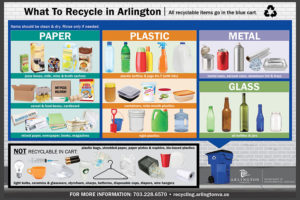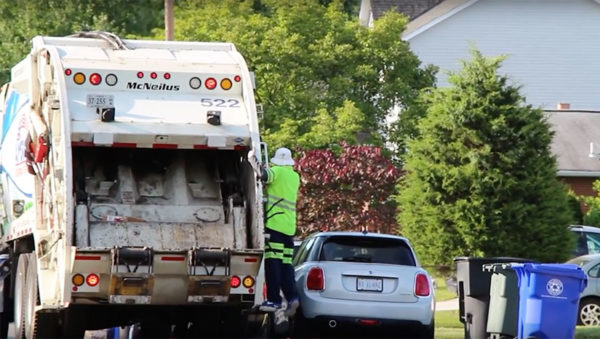(Updated at 1 p.m.) Arlington’s 33,000 single family homes generate on average a little more than a ton of garbage and recyclable material apiece, per year. But where exactly does it go?
Erik Grabowksy, Arlington County’s Solid Waste Bureau Chief, has the answer to that question.
The process starts at home with a system that many residents likely familiar with. Arlington County gives its residents a blue recycling can for recyclables and a black trash can for garbage. Though they’re placed on the same curb, the contents of those cans will end up in two different places.
 Collection crews take paper, bottles, cans and plastic to a processing center in Merrifield where those items are converted into raw materials for sale on the commodities market, Grabowsky said. (An earlier version of this article reported erroneously that the processing center was in Manassas.)
Collection crews take paper, bottles, cans and plastic to a processing center in Merrifield where those items are converted into raw materials for sale on the commodities market, Grabowsky said. (An earlier version of this article reported erroneously that the processing center was in Manassas.)
The raw materials then go to a facility in Elkridge, Maryland for further processing.
“That is basically paper, cardboard, aluminum, steel cans, plastic bottles and that type of material,” Grabowsky said. “That material is collected in a separate truck and taken to what is called a material recovery facility where there is a series of conveyors and sorting processes which separate the material into different commodities.”
If it’s regular trash, it travels to a Covanta Energy facility in Alexandria where it is burned to generate electricity. According to Covanta, the facility can process up to 970 tons of trash each day and generate up to 23 megawatts of energy.
“On the waste hierarchy — when you talk about reduce, reuse, recycle — incineration is above landfilling because it has some value with energy recovery associated with it,” said Grabowsky.
Grabowsky said the facility complies with EPA standards and that, because of the location, it is constantly evaluated to strict emissions standards.
“Because of the EPA and the fact that we’re in a non-attainment area, we have very high air emissions standards,” he said. “The plant is evaluated constantly and it is way below the EPA established threshold for any kind of toxins or SO2 (sulfur dioxide).”
Along with recyclables and regular trash, county workers also collect electronic, metal and yard waste. The metal is converted into scrap and sold while the electronic waste is taken to be deconstructed and stripped of valuable minerals and other components.
For yard waste, it is taken to a facility where it is ground up into compost used to enrich the soil, Grabowski said.
“We have a very comprehensive collection system with a whole bunch of different material going in different directions,”said Grabowsky. “We want them to be used in their highest and best use. We try to stay away from landfilling and recycle as much as possible.”
Video by Omar DeBrew


